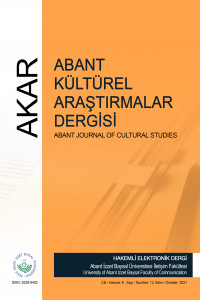Öz
Cinsel taciz, her türlü cinsiyetçiliği, istenmeyen cinsel ilgiyi ve cinsel baskıyı içeren bir ayırımcılık şeklidir. Faillerin cinsel tacizle ilgili motivasyonları arasında doyum arayanların duyduğu cinsel arzu, tehdit altında cinsiyet kimliğini savunma isteği ve güç ve cinsiyet arasındaki iktidar ilişkileri yer almaktadır. Araştırmanın konusu olan ve Pryor tarafından geliştirilen “Cinsel Tacizde Bulunmaya Yatkınlık Ölçeği”, erkeğin güçlü konumlarda tanımlandığı on ayrı senaryosuyla, katılımcının cinsel tacize neden olabilecek bir güç ihtiyacının olup olmadığının tespiti için kullanılmaktadır. Bu çalışmada 1987’de Pryor tarafından geliştirilen “Cinsel Tacizde Bulunmaya Yatkınlık Ölçeği” Türkçeye uyarlanarak, ölçeğin geçerlilik ve güvenilirliği test edilmiştir. Ölçek toplam on senaryodan oluşmaktadır. Araştırmada nicel bir yöntem olan anket aracılığıyla 393 kişiden veri toplanmıştır. Çalışmanın Türkçeye çeviri aşamasında nitel araştırma yöntemlerinden biri olan grup odak görüşmesi kullanılmıştır. Elde edilen veriler, istatistiksel analiz programları yardımıyla test edilmiştir. Araştırmanın sonuçlarına göre Türkçeye uyarlanan Cinsel Tacizde Bulunmaya Yatkınlık Ölçeği yüksek düzeyde geçerlilik ve güvenilirlik koşulunu sağlamıştır.
Anahtar Kelimeler
Cinsel Taciz Cinsel Taciz Ölçeği Havacılık Türkçeye Uyarlanma
Kaynakça
- Anene, Francisca, & Osayamwen, Laura (2019) Clear and Present Danger! Quid-Pro-Quo Sexual Harassment as a Limitation to Female Access to Quality Tertiary Education in South-West Nigeria. 05. Conference Proceedings & Working Papers Pan-Commonwealth Forum 9 (PCF9), 2019.
- Bandura, Albert (2010) İnsanlıkdışı Suçların İşlenmesinde Ahlâkî Bağlantının Kesilmesi, Çev. Hamdi Onay. Hikmet Yurdu, 3(6): 235-269.
- Bargh, John, & Raymond, Paula (1995) The naive misuse of power: Nonconscious sources of sexual harassment. Journal of Social Issues, 51(1): 85-96.
- Bargh, John, Raymond, Paula, Pryor, John, & Strack, Fritz (1995) Attractiveness of the underling: An automatic power sex association and its consequences for sexual harassment and aggression. Journal of Personality and Social Psychology, 68(5): 768-781
- Baş, Eylem (2016) Türk Ceza Hukukunda Cinsel Taciz Suçu. Ankara Üni. Hukuk Fak. Dergisi, 65(4): 1135-1215.
- Begany, Joseph, & Milburn, Michael (2002) Psychological predictors of sexual harassment: Authoritarianism, hostile sexism, and rape myths. Psychology of Men & Masculinity, 3(2): 119.
- Benya, Frazier, Widnall, Sheila & Johnson, Paula (2018) Sexual Harassment of Women. Climate, Culture, and Consequences in Academic Sciences, Engineering, and Medicine. National Academies of Sciences, Engineering, and Medicine; Policy and Global Affairs; Committee on Women in Science, Engineering, and Medicine; Committee on the Impacts of Sexual Harassment in Academia. Washington (DC): National Academies Press (US); 2018 Jun 12.
- Büyüköztürk, Şener (2011) Sosyal bilimler için veri analizi el kitabı. Ankara: Pegem Akademi.
- Coşkun, Recai, Altunışık, Remzi & Yıldırım, Engin (2019) Sosyal Bilimlerde Araştırma Yöntemleri SPSS Uygulamalı, Sakarya: Sakarya Yayıncılık.
- Çapık, Cantürk, Gözüm, Sebahat & Aksayan, Seçil (2018) Kültürlerarası Ölçek Uyarlama Aşamaları, Dil ve Kültür Uyarlaması: Güncellenmiş Rehber. Florence Nightingale Hemşirelik Dergisi, 26(3): 199–210.
- Farley, Lin (1978) Sexual shakedown: The sexual harassment of women on the job. New York: McGraw-Hill.
- Festinger, Leon (1957) A theory of cognitive dissonance. Evanston, IL: Row, Peterson.
- Fitzgerald, Louise, Gelfand, Michele & Drasgow, Fritz (1995) Measuring sexual harassment: Theoretical and psychometric advances. Basic and Applied Social Psychology, (17): 425-445.
- Galdi, Silvia, Maass, Anne, & Cadinu, Mara (2014) Objectifying media: Their effect on gender role norms and sexual harassment of women. Psychology of Women Quarterly, 38(3): 398-413.
- Gutek, Barbara (1985) Sex and the workplace. San Francisco: Jossey-Bass.
- Gutek, Barbara, & Morasch, Bruce (1982) Sex-Ratios, Sex-Role Spillover, and Sexual Harassment of Women at Work. Journal of Social Issues, 38(4): 55–74.
- Johnson, James, Adams, Mike, Ashburn, Leslie & Reed, William (1995) Differential gender effects of exposure to rap music on African American adolescents’ acceptance of teen dating violence. Sex Roles, (33): 597405.
- Karabulut, Özge & Yalçınkaya Alkar, Özden (2019) Toplu taşımada kadın: Toplu taşımada cinsel mağduriyet yaşayan ve yaşamayan kadınların psikolojik belirtilerinin karşılaştırılması. Klinik Psikoloji Dergisi, 3(1): 1-16.
- Lévi-Strauss, Claude (1969) The elementary structures of kinship (No. 340). Boston, MA: Beacon Press.
- MacKinnon, Catharine (2015) Feminist bir devlet kuramina doğru. İstanbul: Metis Yayınları.
- McKinnon, Catharine (1979) Sexual Harassment of Working Women: A Case of Sex Discrimination, Catharine A.
- MacKinnon (Vol. 19). New Haven: Yale University Press.
- O’Leary-Kelly, Anne, Paetzold, Ramona, & Griffin, Ricky (2000) Sexual harassment as aggressive behavior: An actor-based perspective. Academy of Management Review, (25): 372-388.
- O'Leary-Kelly, Anne, Bowes-Sperry, Lynn, Bates, Colette Arens & Lean, Emily. (2009). Sexual harassment at work: A decade (plus) of progress. Journal of Management, 35(3): 503-536.
- Page, Thomas, Pina, Afroditi, & Giner‐Sorolla, Roger (2016) “It was only harmless banter!” The development and preliminary validation of the moral disengagement in sexual harassment scale. Aggressive Behavior, 42: 254–273. (First published: 09 September 2015
- Pryor, John (1987) Sexual harassment proclivities in men. Sex Roles, 17(5): 269-290.
- Pryor, John, LaVite, Christine & Stoller, Lynnette (1993) A social psychological analysis of sexual harassment: The person/situation interaction. Journal of Vocational Behavior (Special Issue), (42): 68-83
- Sakallı, Nuray, & Türkoğlu, Beril (2019) “Erkek” Olmak ya da Olmamak: Sosyal Psikolojik Açıdan Erkeksilik/Erkeklik Çalışmaları. Türk Psikoloji Yazıları, 22(44): 52-76.
- Sharon, Gurwitz & Panciera, Lawrence (1975) Attributions of Freedom by Actors and Observers. Journal of Personality and Social Psychology, 32(3): 531-539.
- Stockdale, Margaret, Visio, Michelle & Batra, Leena (1999) The sexual harassment of men: Evidence for a Broader Theory of Sexual Harassment and Sex Discrimination. Psychology Public Policy and Law, 5(3): 630-664.
- Şencan, Hüner (2005) Sosyal ve davranışsal ölçümlerde güvenilirlik ve geçerlilik. Ankara: Seçkin yayıncılık.
- Timmerman, Greetje & Bajema, Cristien (1998) Sexual Harassment in Northwest EuropeA Cross-Cultural Comparison. European Journal of Women s Studies, 6(4): 419-439.
- Walker, William, Rowe, Robert & Quinsey, Vernon (1993) Authoritarianism and sexual aggression. Journal of personality and social psychology, 65(5): 1036-1045.
- Wan, William (2017, 22 Aralık) What makes some men sexual harassers? Science tries to explain the creeps of the world. The Washington Post. Erişim Adresi: https://www.washingtonpost.com/news/speaking-of-science/wp/2017/12/20/what-makes-some-men-sexual-harassers-science-tries-to-explain-the-harvey-weinsteins-of-the-world/
Ayrıntılar
| Birincil Dil | Türkçe |
|---|---|
| Konular | İletişim ve Medya Çalışmaları |
| Bölüm | Makaleler |
| Yazarlar | |
| Yayımlanma Tarihi | 30 Ekim 2021 |
| Kabul Tarihi | 27 Ekim 2021 |
| Yayımlandığı Sayı | Yıl 2021 Cilt: 6 Sayı: 12 |


